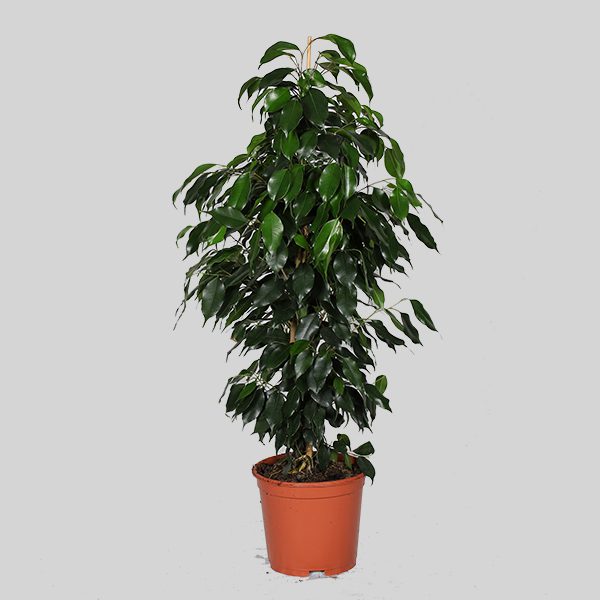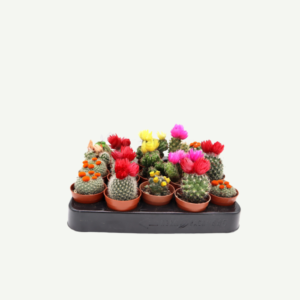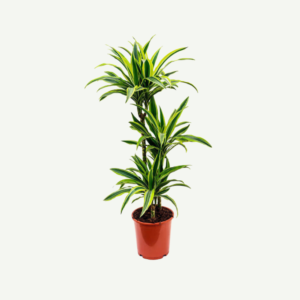Ficus benjamina, commonly known as the Weeping Fig, is a popular and versatile indoor plant. It belongs to the Moraceae family and is native to Southeast Asia and Australia. Ficus benjamina is appreciated for its graceful, arching branches and lush foliage, making it a great choice for adding greenery and elegance to indoor spaces.
Care of Ficus benjamina:
Light Requirements: Place Ficus benjamina in a location with bright, indirect light. It can tolerate lower light conditions, but it thrives in well-lit areas away from direct sunlight.
Temperature : Ficus benjamina prefers temperatures between 60°F to 75°F (15°C to 24°C) and is sensitive to cold drafts. Avoid placing it near air conditioning vents or doors that may expose it to cold air.
Watering : Allow the top inch or two of the soil to dry between waterings. Water thoroughly and avoid overwatering, as Ficus benjamina is susceptible to root rot.
Humidity : Ficus benjamina appreciates higher humidity levels. Regular misting or placing a humidity tray nearby can help maintain adequate moisture.
Soil : Use well-draining potting soil suitable for indoor plants.
Fertilizer : Feed the plant with a balanced, water-soluble fertilizer during the growing season (spring and summer) every 2-4 weeks. Reduce or stop fertilizing in the winter when growth slows down.
Pruning : Prune Ficus benjamina to maintain its shape and size, remove any dead or yellowing leaves, and encourage branching.
Repotting : Repot the plant every two to three years or when the roots outgrow the current container. Choose a slightly larger pot with good drainage.
Characteristics of Ficus benjamina :
Leaves :The leaves are generally small, lance-shaped, and glossy. They are dark green, although variegated cultivars with lighter colors or white edges are also available.The leaves alternate along the branches and are arranged in a spiral pattern.
Growth Habit: Ficus benjamina has an upright and spreading growth habit. In its natural environment, it can become a large tree, but when grown as a houseplant, it is often kept as a compact shrub or small tree through pruning.
Weeping Form :The branches have a weeping or drooping appearance, adding to the plant’s graceful and elegant demeanor.As the plant matures, it may develop aerial roots that can contribute to its distinctive appearance.
Trunk : The trunk of Ficus benjamina is typically slender and grayish-brown, with a smooth texture. It may develop a more gnarled and interesting appearance as the plant ages.
Flowers and Fruits : In indoor settings, Ficus benjamina rarely produces flowers or fruits. The inconspicuous flowers are usually hidden within the foliage, and the fruits are small, fleshy figs that may appear in pairs.
Light Requirements : Ficus benjamina prefers bright, indirect light. It can tolerate lower light levels, but too little light may result in leaf drop.
Temperature Tolerance : It thrives in warm temperatures and does not tolerate cold drafts or sudden temperature fluctuations. Avoid placing it near drafts from doors, windows, or HVAC vents.
Watering Needs : Ficus benjamina prefers evenly moist soil. Water the plant when the top inch of the soil feels dry to the touch.Be cautious not to overwater, as this can lead to root rot. Ensure proper drainage in the pot.
Humidity : Ficus benjamina appreciates higher humidity levels. In dry indoor environments, misting the leaves or placing a humidifier nearby can be beneficial.
Pruning : Pruning is often necessary to maintain the desired size and shape. Ficus benjamina responds well to regular pruning, and this can help control its growth and promote bushiness.
Indoor Use : Ficus benjamina is a popular choice for indoor spaces, including homes, offices, and malls, where it is used as a decorative and air-purifying plant.
Potential Allergen: The sap of Ficus benjamina contains latex, which can be an irritant to some individuals. It’s advisable to handle the plant with care, and it may not be suitable for households with pets prone to chewing on plants.
Ficus benjamina is appreciated for its aesthetic appeal and adaptability as a houseplant. With proper care, it can thrive indoors and contribute to the overall ambiance of interior spaces.
Landscaping use of Ficus Benjamina:
Hedging: Ficus benjamina can be used to create dense and attractive hedges. Its weeping form and glossy foliage provide a lush and elegant screen. Regular pruning helps maintain the desired height and shape.
Privacy Screens :Planting Ficus benjamina strategically can create effective privacy screens, blocking unwanted views and providing a green backdrop. This is particularly useful in residential landscapes.
Shade Provider :The dense foliage of Ficus benjamina can provide shade in outdoor spaces. Planting it in locations where shade is desired, such as near patios or seating areas, can enhance comfort during hot weather.
Ornamental Focal Point :Ficus benjamina’s graceful form and attractive foliage make it a suitable choice for ornamental focal points in the landscape. Plant it as a standalone specimen to draw attention and add visual interest.
Container Planting :Due to its adaptability, Ficus benjamina can be grown in containers and placed strategically on patios, decks, or around outdoor seating areas. Containers allow for mobility and versatility in design.
Understory Planting :In garden settings with taller trees or structures, Ficus benjamina can be used as an understory plant. Its weeping branches and glossy leaves add a layered and textured look to the landscape.
Mixed Plantings :Ficus benjamina can be incorporated into mixed plantings with other shrubs, trees, and flowering plants to create a diverse and visually appealing landscape. Consider its mature size and growth habit when planning mixed plantings.
Formal Gardens :In formal garden designs, Ficus benjamina can be shaped into geometric forms or used to define pathways and borders. Its neat appearance and adaptability to pruning make it suitable for formal landscaping.
Educational Gardens :Ficus benjamina can be used in educational or botanical gardens to showcase its unique characteristics and demonstrate its adaptability in different outdoor settings. Informational signage can educate visitors about the plant.
Parks and Public Spaces :Planting Ficus benjamina in parks, public gardens, and other communal spaces can enhance the overall landscape design, providing greenery and a touch of elegance.
Tropical Landscapes :In regions with a tropical climate, Ficus benjamina can be used in tropical landscape designs. Its native habitat is tropical and subtropical regions, making it well-suited for creating a lush and tropical ambiance.
When using Ficus benjamina in landscaping, it’s essential to consider the local climate and its specific requirements. This plant thrives in warm, tropical to subtropical conditions and may not be suitable for areas with cold temperatures or frost. Additionally, regular maintenance, including pruning and proper watering, is crucial to keep the plant healthy and visually appealing in the landscape.






